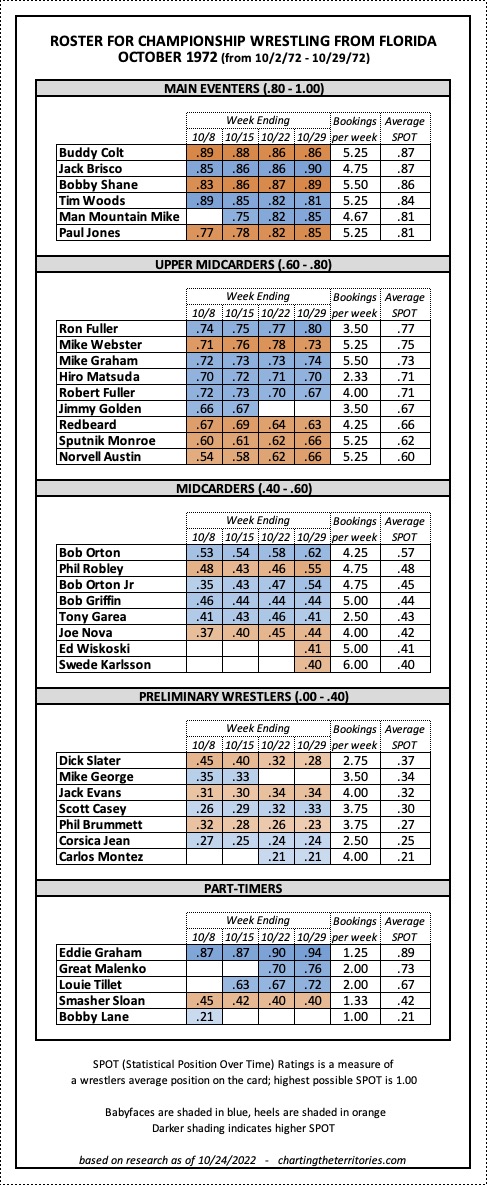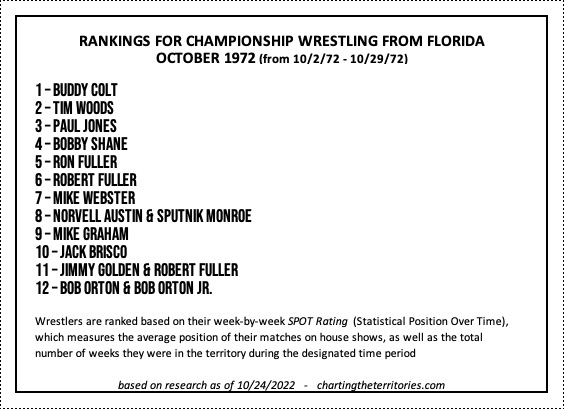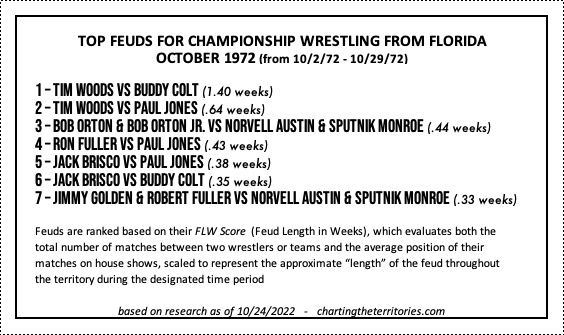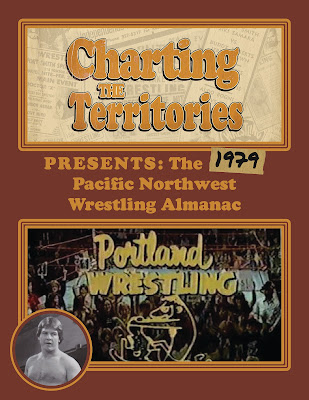A Special Look at Florida in October 1972
With Vice TV’s Tales From The Territories airing on episode on Championship Wrestling from Florida this week, I decided to use the statistics I’ve created (which analyze wrestling in the territorial era) to take a look at what was going on in Florida in October 1972, 50 years ago.
First, the roster. The wrestlers are listed in descending order by their SPOT (Statistical Position Over Time) Rating. Babyfaces are shaded in blue, heels in orange.
Looking at the “full-time” roster, the top babyfaces were Jack Brisco, Tim Woods, and Man Mountain Mike (who came in for about four weeks as a ‘special attraction’ of sorts). The top heels were Buddy Colt, Bobby Shane, and Paul Jones.
Some of the wrestlers on the roster may be better known by other ring names: Redbeard was Doug Gilbert (Doug Lindzy), Phil Robley was Buck Robley, Joe Nova was Butcher Brannigan, Ed Wiskoski was Col. DeBeers.
A few recognizable names are listed in the Part-Timers section. The cutoff for “part-timers” is 40% or less bookings per week than the high end of the roster (NERDY MATH STUFF: for this territory at this time, the high end is 5.36 bookings per week, so anyone with less than 2.15 bookings per week is listed as a part-timer).
Some of these wrestlers primarily competed in singles matches, and some primarily in tag team matches. The Rankings below are an attempt to separate those two, using the week-by-week SPOT Ratings (with singles matches and tag teams being calculated separately) and the number of weeks they were in the territory during the month.
In some instances, wrestlers are listed lower than you might expect in these rankings. This happens when they are frequently in tag team matches with multiple partners. Jack Brisco, Mike Graham, and (to a lesser extent) Bobby Shane are affected by this here. Brisco and Graham (along with Mike’s father Eddie) were feuding with Shane and his cohorts (Mike Webster and Redbeard) in matches with a variety of combinations.
Tim Woods held the Southern Heavyweight title for the entire four-week period. Paul Jones held the Florida Heavyweight title for the entire four-week period. Jimmy Golden & Robert Fuller began the period as Florida Tag Team champions and lost the titles to Norvell Austin & Sputnik Monroe on October 10th. So the two highest "ranked" tag teams held the titles during the month, and two of the three highest "ranked" singles wrestlers held the two singles championships in the territory.
Here are the top feuds for the month as measured by FLW (Feud Length in Weeks).
As with the rankings, wrestlers who are on opposite sides of a variety of match types (singles, tag teams with different partners, six-man tags) are underrepresented here. This adversely affects the Brisco & Mike Graham vs Bobby Shane & friends feud.
A lot of the matches on this list are merely "highly-ranked babyfaces vs highly-ranked heels". For years, many people were of the belief that wrestlers who were "feuding" faced each other every single night for weeks on end. As more and more information has come to light due to the tireless work of wrestling historians, we find that isn't often the case, particularly before the 1980s.
NERDY MATH STUFF: The biggest “feud”, Tim Woods vs Buddy Colt, has an FLW Score of 1.40 for the 4-week period. They had a total of 9 matches against one another in this 4-week period. Six out of those nine matches were main events, while the other three were semi-main events. Both Woods and Colt had 21 total matches during the four weeks. So they had singles matches against one another 42.86% of the time (9 divided by 21). If all the matches had been main events, the FLW Score for this four-week period would have approached 1.71 (42.86% times 4). But because some of them were lower on the cards, it lowered the FLW to 1.40
Finally, here’s a look at the calendar of known house shows. A “known house show” is one where we have either the complete list of matches or at the very least know part of the lineup or a partial listing of wrestlers who were booked on the show.
NERDY MATH STUFF: There are 39 “known house shows”. As we established earlier, the high end of the roster was booked 5.36 times per week on these known house shows. It’s clear that the territory did not run regularly, if at all, on Sundays at this time (this was common for the early 1970s, particularly in the south). Looking at the above calendar, a very reasonable assumption is that they ran two shows per night six nights a week. A possible exception to this was when they ran Jacksonville on Thursdays; on those nights they may have only run the one house show (with a TV taping earlier in the day in Tampa). It is also entirely possible that the first two Mondays listed above, with just one known show in Orlando, were “one house show” nights as well.
MORE NERDY MATH STUFF: If we expect much of the high end of the roster to be booked six nights per week, that means our records are approximately 89.3% complete (5.36 divided by 6). Taking into consideration that some of the top stars may be booked outside of the territory every now and again (perhaps in St. Louis or large nearby territories like Georgia or Crockett), it’s probably a little more complete than that. In all likelihood, we’re missing no less than 5 shows and no more than 9. Two on the first Saturday, one each on the following two Saturdays, one on the third Thursday, and possibly one each on the first two Mondays and the first two Thursdays. In all of those cases, the shows are likely smaller in scale than the ones in the major cities like Orlando, Tampa, Miami/Miami Beach, and Jacksonville. So again, the estimate of the data being a little more than 90% complete still holds true (it’s NOT 90% of total shows, it’s 90% of total bookings; a show with a smaller crew would count less than one in a major city).






